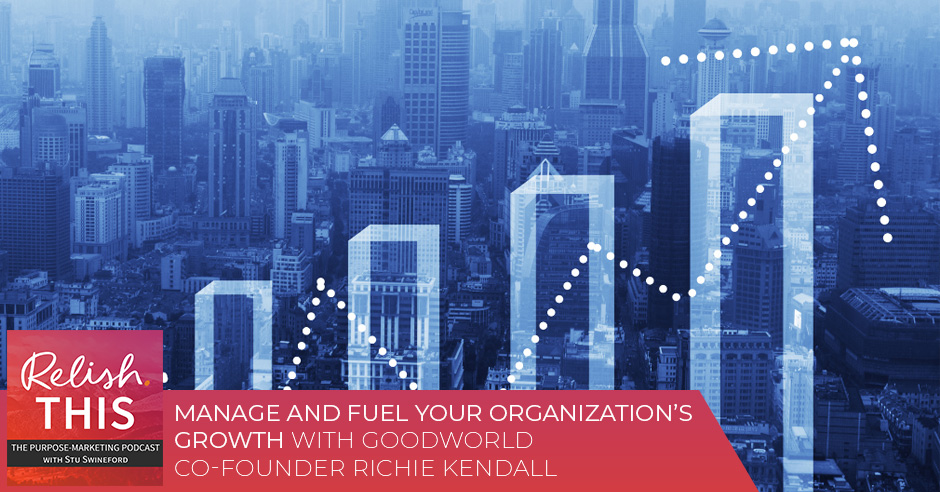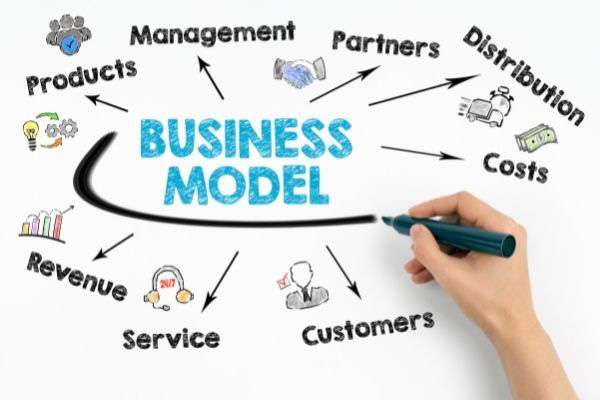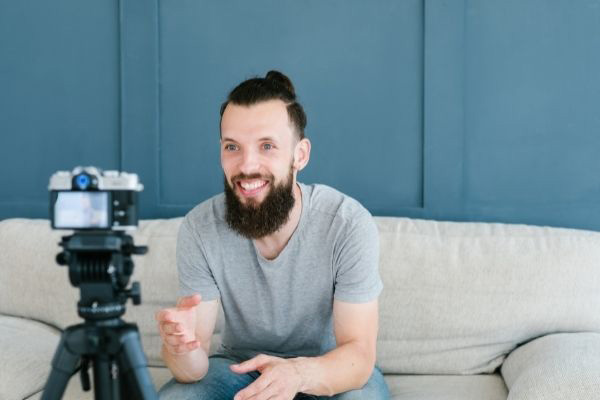
My guest today is Richie Kendall, the co-founder of Goodworld, an AMAZING tech stack that helps organizations (both nonprofit and for-profit) manage and fuel their growth. Richie’s platform combines many great features in one platform, making it easier to coordinate your outreach for maximum effect.
In my opinion, nonprofit organizations could especially benefit from using Goodworld to have all of their events, social giving, and rounding up campaigns all in one easy-to-view place. This would help to reduce costs and cut down on time wasted learning multiple platforms. Richie and I had a great conversation and I hope you enjoy it.
Link:
Action Ask:
Educate yourself on where the world is moving. Encourage your leadership and workforce to engage in ritualistic good to provide the time and space, perks and incentives to have a stronger connection.
—
Listen to the podcast here:
Manage And Fuel Your Organization’s Growth With Goodworld Co-founder Richie Kendall
My guest is Richie Kendall. He is one of the cofounders of a cool organization that has this tech stack for nonprofits and purpose-driven for-profits. It’s called Goodworld. You should definitely check it out. This episode is packed with some cool information. They built this platform to try and help nonprofits solve a couple of problems. One is juggling platforms and having so many tools that your costs are through the roof. The time that it takes to learn and understand how to use all those tools is high.
Also, your data in that situation is all over the place. Goodworld helps solve those problems. This is a great episode for both purpose-driven companies looking to expand their CSR as well as nonprofits. It’s looking to bring all of those activities, events, social giving, and rounding up under a single roof. This is the episode for you. I hope you enjoy it. Richie is great. Here we go.
—
Thanks for joining me, Richie.
Thanks for having me, Stu.
I’m excited to hear more about what you are up to over there at Goodworld. It sounds like you have some cool things going on with essentially a tech stack.
We fancy ourselves a social impact operating system, but we got started as an app that turned into an all-in-one fundraising toolset.
You work with nonprofits. I know that you have a for-profit component to your systems as well. Why don’t you run us through what your systems help people achieve?
I will back up a little bit further and give the windup on how I worked into this space and how we got to be doing what we are doing. I grew up in Colorado as a studio artist. I got into digital pretty early on. I was taking on some clients as early as high school and doing things like graphic design and identity work. Nonprofits became my first tranche of early partners. I found a heart for working with nonprofits because of all of the amazing stories and work that they were doing. As someone who lost my father to cancer very early, I was confronted with those existential questions as young as 6 and 7 years old. I always pursued a life of purpose.
In a changing landscape, the technology accelerating at an extreme pace and sometimes it’s hard to really see the forest through the trees.
When I started a film career after college, about eight years after editing, writing, and producing, I had been moonlighting for these nonprofits doing websites and logos. After that career, I decided, “Why not go all-in on my nonprofit work, take everything I have learned, deliver that as a form of visual storytelling expertise consulting, and build up a client list?” After about a year in with my new creative agency called Cheerful Inc, I bumped into someone who became my business partner who had started the first technology that lets you round up the change on your purchases for charities.
We decided to go in together and build the company out as Cheerful Giving. We white-labeled that technology for the nonprofit sector and got some pretty great clients and brands going within the first two years. We ran a B2B sales model selling that technology into the nonprofit space. By the end of 2019, we were an all-in-one fundraising solution for the nonprofit sector. We were acquired by Goodworld which I’m the Cofounder and Chief Experience Officer.
That’s an interesting story. I’m very sorry to hear that you lost your father at a young age. I know that is hard enough when people are older. I want to acknowledge that. That must have been a real challenge.
The strength of my mother translated into the strength of a family. We pushed through. We may be all the better for it.
I commend you for taking that experience and turning it into something incredibly positive. It sounds cool what you have built. Tell me a little bit about the types of nonprofits that your systems tend to work best for.
We do work with nonprofits of all shapes and sizes, but the size depends on the partnership in some ways. For some of our larger nonprofit partners like American Cancer Society, Amnesty International, YMCAs, and things like that, it’s usually more on the innovation side. Not only were we the first-mover in creating an app and platform that lets you round up the change on your purchases, but we were also the inventor of a tool called #donate. That lets an individual on Facebook and Twitter simply type the word #donate into a comment field. When you do that, that creates an instant donation. It gets the nonprofit and all of the donor information. It’s a very social pile-on way to raise funds through your social channels.

With our larger relationships, they are pretty focused on our more innovative tools that reach younger audiences. With your smaller nonprofits and even your mid-market, we act as a multichannel all-in-one fundraising toolset that helps them consolidate their platforms, get all of their data into one place, streamline their operations, and run predictable and successful events, peer-to-peer fundraising, team fundraising and more.
I’m on the board of a couple of nonprofits. There’s always a struggle with what tools to put into place and how to make sure that they are focused on those things that matter the most. One of the things that I have seen happen is this challenge with juggling so many different tools that not only do your costs go up quite significantly, but you also have to learn all of these different systems. I could see how having everything under one roof would be a real benefit to a lot of nonprofits out there.
We feel for those nonprofits, especially in a changing landscape where not only is the technology accelerating at an extreme pace, but there’s a glut of information, consultants, and different toolsets out there. Sometimes, it’s hard to see the forest through the trees. I likened it to preparing good meals. It’s not that you don’t have more than one tool or ingredient. That’s all very important, but having different platforms is like trying to cook out of multiple kitchens simultaneously. If we can get all of the right ingredients in the right kitchen with the right vision, then that’s how you are going to scale your efforts most effectively.
I love that analogy. That paints a pretty compelling picture. If you had to prepare the spaghetti in one kitchen and you are cooking the sauce in some completely different kitchen, that’s not particularly efficient.
Nonprofits, like for-profit businesses, are in the business of optimizing their business model. They need to stay focused on their mission and programs. They can’t be over-exercising themselves on technology and management.
I’m curious to hear a little bit more about the #donate platform or program. How does that work?
It’s a little bit of magic. Back in 2015, we created this concept. My business partner, Gayle Pfeiffer, got to pitch Obama, who saw a huge opportunity in it right on the back of the ALS challenge. When we saw this huge social media spike, even considering how much money that campaign raised, it was less than 2% conversion on donations. We saw that as an opportunity to make the social donation processes frictionless as possible.
It was right at the beginning of the #trend. We realized, “If you could create a hashtag that would enable someone to trigger a donation automatically and they wouldn’t have to complete some long online form, this could be a huge save in this space.” It was a layer that we were able to build on top of Facebook as an app.
If you can get all of the right ingredients in the right kitchen, with the right vision, that’s how you’re going to most effectively scale your efforts.
We built it on top of Twitter as well in terms of retweets. If you type #donate into Twitter, that will trigger an automatic response from the page that will provide a link to add your card the first time. Once we have your card on file, then anytime you type #donate moving forward, it will simply trigger a donation of the amount you include. #donate$100 will draw right from your card.
If I’m responding to Save the Children’s post on Facebook, for example, and I type #donate$100, will it kick off a donation of that amount to that organization?
That’s correct. You will get a receipt right in your inbox. Save the Children will not be subject to the data hole that Facebook is. They will get your information about your donation in real-time.
That seems like a cool system. You said it works on Facebook and Twitter.
Since Instagram doesn’t include any linking in the platform, we have a Swipe Up on Instagram, but it’s not quite as magical as the #donate.
A lot of people out there will be excited to learn more about that system. Do they need to sign up with you, the nonprofits themselves, or it just works?
It’s very easy. You go to GoodworldNow.com and enroll with us. With a couple of clicks, have your Facebook and Twitter managers connect Facebook and Twitter. Now, your social feeds have those magic powers.
I would encourage people out there to check that out, particularly those that have a solid follower base on those two platforms. That seems amazing.
Animal rights, welfare shelters and rescues do particularly well. As you can imagine, cute animal pictures go a long way. It’s powerful how much funds you can raise with more emergent relief needs.

When people are paying particularly strong attention to what is going on out there, I could see that being a real benefit to drive donations during those catastrophes or other types of urgent events.
The cool thing is that the influencers can also link their accounts to us. You have some powerful voices in your corner. Having your influencers link up to us, anyone can type or retweet #donate to that influencer account and it will go straight to your fund.
If an influencer is connected with a particular charity and they connect their account, then that charity is the beneficiary of the #donate platform. That’s some creative thinking. I’m excited to see where you are going with that because that’s some good stuff. Tell us a little bit more, particularly about some of the other technologies that are associated with the Goodworld platform.
Roundups are a great place to start because that’s where I got my start in the technology sector. I had been working with these nonprofits and understanding some of their pain points operationally. I was servicing them from a creative point of view. What I was learning is that there was this shift happening in the way that donors are engaging with philanthropy in general. I got the bug for helping crack that nut in understanding, “How can we get younger people, Millennials and Gen Z, involved in causes?”
This was around the time that some of the investing and savings tools began to emerge. The Keep the Change Bank of America platform lets wrap up your transactions for your savings accounts. You get this whole slew of Acorns for investing, Cash App, Robinhood and now the whole ecosystem of investing tools out there. We thought, “If you can do this for investing and savings, why not be able to support a cause you care about?”
With a couple of third parties, we use our Stripe payment processor for payment processing and a platform called Plaid, which lets you link into well over 9,600 financial institutions across the country. We were able to allow donors to track their everyday purchases and automatically round up every purchase they make for a charity. Roundups are a mainstay for us. We are seeing a lot of applications, not only in the nonprofit sector but also it’s being used by businesses and their employees to create giveback cards and perks when you buy lunch or make a business transaction.
What is so powerful about this is it’s a recurring revenue stream with a very low barrier to entry. If you round up a little bit of change every day, it makes a big difference and up to $20 a month in spare change on your transactions. If 100 people are rounding up their spare change, that’s $20,000 a year in recurring revenue. That’s a game-changer for small nonprofits.
In a way, brands are becoming more human, and at the same time, humans are becoming more like brands.
Do nonprofits that want to participate in the roundups program is a separate engagement? Does that come with all the other great tools that you provide with your services? How do people get engaged with that platform and program?
The beauty of our offering is we keep it very simple. We have the entire base platform completely free for nonprofits. There are no upfront costs. If you want to leverage any of our tools, aside from a couple of special tools and support levels, it’s free. All we do is encourage all donors to tip when they are completing their transactions or signing up for recurring revenue. A nonprofit of any shape and size can get access to a full-donor CRM, roundups, #donate events, auctions, peer-to-peer donations and more, all for no upfront costs.
What is your revenue model? Is it purely tip-based in terms of people who are engaging with that nonprofit?
Our free tier is fully tip-driven. If a nonprofit prefers to have what we call a fully-branded platform that is more of an insulated database, not a part of our shared free ecosystem, then that starts at $99 a month for the whole base of tools. You are giving pages, forms, spare change and a few others.
People are fairly familiar with the AmazonSmile program, which donates a percentage of each transaction. Rounding up is something that can be a lot more powerful in a lot of ways because of how that works from a mentality standpoint. A lot of times, it could be a bigger percentage than even what AmazonSmile is doing. It’s cool that you have that as an option for nonprofits for people to take advantage of.
I appreciate you identifying that. We are less in the business of creating frill streams. We are putting cutting-edge tools and technologies that are higher retention, higher engagement, and more usable in the hands of nonprofits as a part of their primary toolset so that they are not just signing up for a million platforms and seeing the money trickle in without the insights. That’s why we want to get them a world-class stack so that they can truly build out an engaged community rather than stretching themselves thin across a whole variety of tools.
What were the biggest challenges that you saw in the nonprofit space that your technology sought to fix when you first started building that out?
The first thing we identified when working with nonprofits is they have too many platforms and their data is all over the place. The only way that you are going to be able to cultivate a community is by creating a cohesive message and communication strategy and also offering a value proposition in a way that feels fresh that communicates your mission and is not just a banker’s errand.

By bringing all the tools into one place, we are truly empowering development directors, associate directors, and even database managers to identify the highest-value prospects and deliver triggered content at giving levels where people are expecting it. I’m not going to say gone are the days of direct mailing or anything like that. Those are still quite strong streams for that Gen X and older audience, but younger people don’t respond to those channels. They are looking for mobile-forward experiences, creative auctions, events, and virtual experiences in the light that are going to meet them more where they are.
I love that you brought that up because one of the things that we have seen comes through some research that an organization called NextAfter has done. Tim was on the show. They do some amazing things with data. One of the things that they have seen is one of the reasons email continues to be so effective is because the main donor base continues to be Boomers. They have money earmarked for donation-based activities. They are hoping to make a difference as they are entering retirement in that phase of their lives.
Having a platform, program, and system in place that enables you to continue to do those activities and show up very strongly with that demographic of Gen X-ers and Boomers but also start to play effectively in those younger generations’ playgrounds and where they show up is a great way to diversify your income streams.
I believe what it also will do is to help organizations that have a long-term plan and focus be able to engage with those younger audiences and keep them as donors and engaged volunteers for the rest of their lives. Recognizing that the younger generations interact vastly differently and coming up with a solution for that is such a strong play for many nonprofits.
The train has left the station. It’s not that you can’t catch it. We truly are in a moment of a generational transformation in the way individuals interact with not only causes but technologies on the whole. That window of capturing younger audiences is closing. If you don’t make a move towards digital and understanding the landscape there, then you run the risk of a cliff ten years away, where you won’t have an audience that knows who you are and what you are doing.
It’s interesting that you mentioned that, too, because I know that you have a for-profit play as well. There are many companies out there that are starting to recognize that younger generations want to engage with brands that have more of a purpose-driven component to their businesses. Tell us a little bit more about what Goodworld does for the for-profit sector as well.
We have seen all this transformation happening in the nonprofit industry. It’s somewhat a function of what is happening in the economy across the board. You have a younger generation entering the workforce. In a way, brands are becoming more human and at the same time, humans are becoming more like brands. We are putting ourselves out there with The Truman Show-style on the internet.
We believe that brands that will pioneer the future are brands that invest in their workplace and culture, take a stand on important social issues, and command an audience and a consumer base that cares about making the world better by voting with their dollars. We have always had it as a part of our vision to build an ecosystem that is three-pronged.
In too many ways, capitalism is pulling our strings when should we should really be putting our values forward in our everyday transactions.
One is the consumer or donor-level pillar. One is the nonprofit sector that is making change happen at scale in impacted areas that affect our daily lives. You have this brand or company’s pillar. When you bring those three pieces together, it’s a recipe for a virtuous cycle of incentives. As consumers, we want to see a better world. We want to interact with brands and experiences that put the all-stakeholder approach to the next generation economy at the forefront.
Nonprofits are looking to heal our communities, heal the planet, and create alleviation to some of the world’s most pressing challenges like hunger and social justice issues. You have got brands that are still in that mode of needing to build loyal customer bases. There’s a way to connect all three of those things. We think that partnering on impact is the way to do it.
If a brand can take a portion of their budget or philanthropic commitment and create programs for their employees to engage them in creating a better culture that has a higher purpose that is more productive and profitable, that’s good for them. That will translate into happier customers who are partnering to create a better world. The nonprofits get to be the beneficiaries of all of that to do the hard work of solutions-making. We see ourselves at the nexus of that triangle and believe that’s the future of an economy that is equitable, diverse, and solves problems.
You have hit the nail on the head there, in a lot of respects. We do live in this ecosystem. We have the opportunities as a for-profit, nonprofit, donors, volunteers, and consumers. It’s all of those different hats that we wear as people to advance things and create a positive impact wherever we go. As we choose to interact with brands, we have that ability to say, “Here’s what we want to see happen.” When brands can authentically get onto that corporate social responsibility train, it makes the world a better place. It’s cool that you have some tools in play that can help with that. What are some of the things in your stack that are helpful for for-profit brands?
Maybe one thing I would love to deal with is the idea that there can be quite a bit of noise and even virtue signaling in the consumer landscape. There are trends that incentivize brands to maybe take a stand on an issue to avoid some shareholder pain or reputational alleviation. At Goodworld, we are in the business of helping them authentically engage in the future that is better for everybody.
One example would be a very sustainable way to engage their employees. It’s something we call Payroll Giving, which enables an individual to take a small part of every paycheck, deduct that from their paycheck and give it to a nonprofit of choice. Across an employee base, that makes a massive difference. Another thing that we offer is roundups for employee cards. Whenever you connect the card every time you buy lunch, you can round up the change on that purchase.
A big concept that we are offering brands is something that we call GiveCards. It occurred to me that if we could take a large corporate commitment, let’s say it’s a $100,000 philanthropic budget. Instead of writing a big check to a single nonprofit with a press release, we cut that commitment up into tiny pieces. We offer it as social credits to employees and consumers.

What happens when you give someone a gift and allow them to choose where the money goes is you turn the cycle and make it a give-first experience. If I got an email that says, “Here’s $25 to give to the charity of your choice after a tough year of COVID,” that’s going to mean so much more than just reading that my employer wrote a big check to a legacy institution. Now, I’m a part of it.
I like the mentality there. It gives people not just the feeling but the ability to create their own change there.
Ultimately, what is powerful about this is it’s a multiplication scheme. When a big brand or even an influencer makes a large commitment and spreads it across a community of people, the more people that touch the money, the more opportunities there are to add, match, increase and spread those dollars. If I dropped $100,000 on my employee base and 2,000 people touched the money and we nudged every person who redeems to chip in a little, you may have turned $100,000 into $300,000, $500,000 or $700,000.
There are a couple of other things that are interesting. Relish Studio is my business. We are a 1% for the Planet partner. One of the things that I know that they have been able to do is to get people to sign on as the 1% as individual donors and then get their businesses to do a match on what they are giving. Essentially, they doubled their impact. Particularly, if the business that you are with has some commitment like that, many businesses do have donation matches or charity matches. They give for volunteer hours and things of that nature. There is a big movement in CSR that you are tapping into there.
The other piece that’s interesting, and I don’t know a ton about this, but I have read a little bit about it. A lot of times, the corporations like the press that comes from giving a giant donation to a marquee nonprofit, the amount of goodness that a small nonprofit can make with a fraction of that money is astounding. It’s amazing to see what good can happen when you take those large donations, facilitate the opportunity to break those up, and give to some smaller organizations. A small organization doing some solid local work can make a $10,000 or $100,000 donation go far away. For some of those large organizations, a $10,000 donation is a drop in the bucket. It’s cool that you are facilitating that opportunity.
It’s about the democratization of philanthropy. It’s moving away from that elitist model into a true upvote economy. If big brands that have the means to make philanthropic commitments are ready to understand the philanthropic DNA of their employees and customers in a new way, they are going to be way out ahead of their competitors. They are going to be able to work on not only problems that the world is facing, but they are also going to create a meaning-filled community around them that’s going to stick with them over the course of decades.
It sounds like for-profit businesses would need to sign up for your tool as well. Do they take advantage of the full stack with that CRM and all of those other mechanisms? Is it focused on a few of the giving opportunities?
Every partner is different. It’s why we offer à la carte technology. In some cases, you will have an organization that knows exactly what they want or the specific use cases that their employees are going to be interested in. Maybe it’s peer-to-peer fundraising. They want to offer their employees the ability to create fundraisers and goals over the course of the year or another organization is pretty focused on some cause marketing efforts, where they want to enable customers to make donations for a specific campaign or impact area.
There’s a more human algorithm to be achieved in this economy where people have gotten so caught up in the incentives of the technology utopian culture.
We have customers that will come in for one tool. Maybe they want to plant trees on behalf of their employees and send them an end-of-the-year holiday card or they want to run a campaign for a special-giving milestone, where they give away a bunch of money, nudge their customers to take some other action or redeem some discounter promo code. There’s a whole myriad of ways you can engage with our toolset. We purposefully architected it for max flexibility so that different brands can engage with the tools in different ways.
I like how flexible the systems appear to be. I haven’t used the system yet, but I’m certainly going to check it out because it seems like an incredible opportunity, both for-profits and nonprofits, to leverage the power of people’s desire to give and create more opportunities there to drive donations and engagement.
I would be happy to give you a personal demo anytime, Stu. I’m happy to send along any resources that your readers may be interested in, whether it’s getting-started tutorials, case studies, or insights that we have come across in the space.
What are some of the trends or next things that you see popping up in the space? What is on tap for you?
We are excited about the intersection of commerce and impact. We are putting some partnerships together that are leading the way on eCommerce integration so that when you are buying a pair of sneakers, you can have the brand trigger a percentage of your purchase towards an impact area of your choice, whether that’s planting trees, providing meals or any other cause area.
We are excited about this democratization approach. Internally, we call this Project G-Force because we believe that there’s a more human algorithm to be achieved in this economy. We have gotten so caught up in the incentives of the machine and the mother-techno utopian culture. In too many ways, capitalism is pulling our strings. We should be putting our values forward in our everyday transactions in how we relate to one another as professionals, colleagues, friends, and members of the same community.
The big grandiose project of our business and the movement we are leading is to bring humanity back into the machine. We think there are going to be so many opportunities to do that with the right partners and leaders taking control of this Capitalism 2.0. We are excited to be meeting people who are leading that charge.
You are spot-on in terms of some of the trends that we are seeing. I will use Amazon again as an example. The fact that one of the world’s largest retailers has a component that allows for charitable donations through its platform is indicative of a more than insignificant shift in attitudes. As you see more and more companies, Walmart is moving toward putting solar on all of their buildings.

There’s increased attention to the idea that we need to try to do a little bit more than just make money. You are certainly onto something. It’s great to see how you are tackling that from a tech standpoint, not only to satisfy those needs but also to engage with new generations that are very much aligned with that idea. At least, that’s what all of the trends are demonstrating.
I admire the conversations that you are leading, Stu. It’s an alliance of humans who are going to get us back on track in terms of a values-first world. It has been an honor to talk to you. I’m sure it’s the beginning of our long rapport.
How can people find out more about what you are doing? What is the best way for them to get in touch?
They can go straight to our website and reach out. If you are part of a nonprofit or business that’s looking to do good, it’s GoodworldNow.com. You can sign up for free and get access to a whole glut of resources. If anyone wants to reach out to me directly, they are free to connect with me on LinkedIn, @RichieKendall or @Goodworld. You can reach me via email and I will respond at Richie@Goodworld.me.
Thank you so much. I love to have these conversations and encourage everyone out there to go and check out all of the great tools that you have developed over there. One of the things that I have been trying to foster on the show is the opportunity for people to take some action. It’s great to have these conversations. It’s awesome to get inspired and think about things. At the end of the day, if we can facilitate and get people to do something to make the world a better place after reading the blog, I’m all for that. I like to end the show with a question. If there was one thing that you would ask the readers to do after reading our conversation, what would that be?
It’s beyond continuing to educate yourself on where the world is going because it’s incredibly important to have the wherewithal to participate in a fast-moving landscape. If you are mid-level or leading a small organization, nonprofit or otherwise, encourage your workforce or leadership to engage in some ritualistic good. When I say ritualistic, I mean that when employee birthdays come around, make a program where you provide them with a charitable gift to go to the cause of their choice. Create time and space for volunteering. Offer perks for good community-focused work. We have to create the incentives, time, and space to have a stronger and more resilient American community. I will encourage everyone to create that space and make that intent.
Thank you so much for being on the show, Richie. I had a great time talking with you. I can’t wait to see what you are up to next.
Me too. Have a great one.
I will talk to you soon.
Important Links:
- Goodworld
- Stripe
- Plaid
- AmazonSmile
- NextAfter
- Tim Kachuriak – Previous episode
- Payroll Giving
- GiveCards
- 1% for the Planet
- @RichieKendall – LinkedIn
- @Goodworld – LinkedIn
- Richie@Goodworld.me
